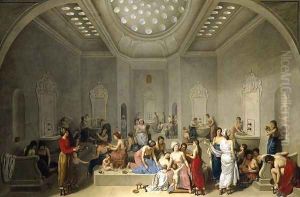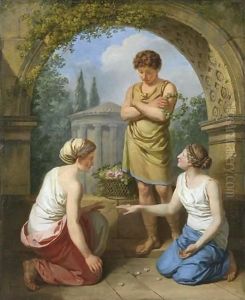Jean-Jacques-Francois Lebarbier Paintings
Jean-Jacques-François Le Barbier, born in 1738 in Rouen, France, was a renowned French painter, illustrator, and engraver whose work encapsulated the Enlightenment's ideals and the early Romanticism that followed. His artistic journey is a reflection of the transitional period in French art, bridging the gap between the Rococo's decorative elegance and the Neoclassical movement's emphasis on simplicity and purity of form. Le Barbier was not just a product of his time; he actively contributed to the evolving narrative of French art, making significant inroads in the realms of historical and allegorical painting.
Le Barbier's early life was steeped in an environment that valued the arts, and he quickly showed a propensity for drawing and painting. His education and talent led him to Paris, where he became a pupil of the celebrated artist Jean-Baptiste Marie Pierre, the Premier peintre du Roi to Louis XV, and later, of Nicolas-Guy Brenet. This grounding provided him with a solid foundation in the techniques and themes that were predominant in French art at the time. He became adept at capturing the human form and imbuing his subjects with a sense of dignity and grace, a skill that would serve him well throughout his career.
He gained recognition for his ability to depict scenes with historical and mythological significance, a talent that aligned well with the Neoclassical movement's ideals. His works often featured themes of heroism, patriotism, and moral virtue, resonating with the ideological shifts of the period leading up to and following the French Revolution. Le Barbier was also a skilled illustrator, contributing to books and literary works of the time, which helped disseminate his fame beyond the confines of the art world.
Throughout his career, Le Barbier exhibited at the prestigious Salon, the official art exhibition of the Académie des Beaux-Arts in Paris. His submissions were well-received, earning him accolades and the patronage of important figures in French society. Despite the political turmoil of his era, Le Barbier managed to navigate the changing tides, adapting his themes and style to suit the evolving tastes of the art-going public and the demands of his patrons.
Le Barbier's legacy is multifaceted; he left behind a body of work that captures the spirit of his time, and his contributions to the visual culture of the Enlightenment and early Romantic periods have been acknowledged by art historians. His influence extended beyond his immediate circle, inspiring future generations of artists to explore themes of national identity and moral virtue. Jean-Jacques-François Le Barbier passed away in 1826, but his art remains a testament to a pivotal moment in French history and the enduring power of visual storytelling.

